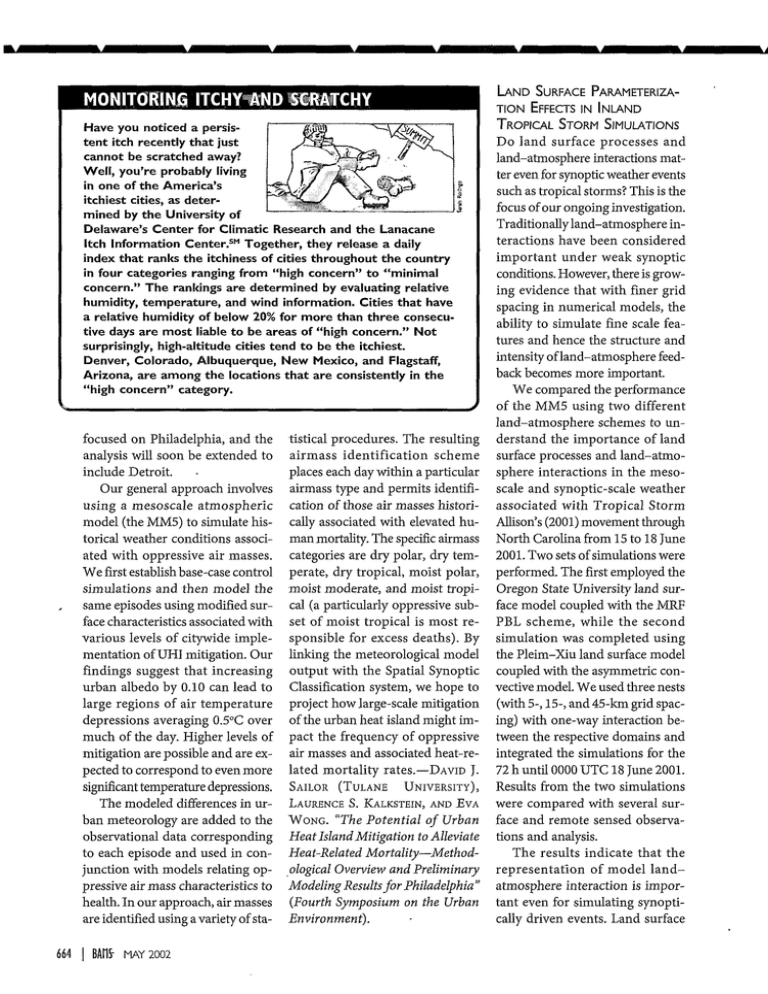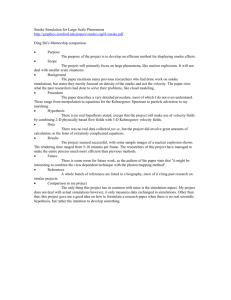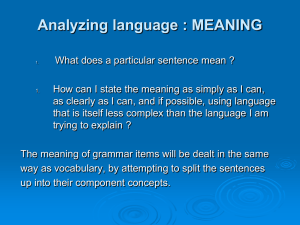
I
I
!k
oicdapess
Haeyo
Have you noticed a persisN
tent itch recently that just
cannot be scratched away?
Well, you're probably living
in one of the America's
itchiest cities, as determined by the University of
Delaware's Center for Climatic Research and the Lanacane
Itch Information Center.SM Together, they release a daily
index that ranks the itchiness of cities throughout the country
in four categories ranging from "high concern" to "minimal
concern." The rankings are determined by evaluating relative
humidity, temperature, and wind information. Cities that have
a relative humidity of below 20% for more than three consecutive days are most liable to be areas of "high concern." Not
surprisingly, high-altitude cities tend to be the itchiest.
Denver, Colorado, Albuquerque, New Mexico, and Flagstaff,
Arizona, are among the locations that are consistently in the
"high concern" category.
focused on Philadelphia, and the
analysis will soon be extended to
include Detroit.
Our general approach involves
using a mesoscale atmospheric
model (the MM5) to simulate historical weather conditions associated with oppressive air masses.
We first establish base-case control
simulations and then model the
same episodes using modified surface characteristics associated with
various levels of citywide implementation of UHI mitigation. Our
findings suggest that increasing
urban albedo by 0.10 can lead to
large regions of air temperature
depressions averaging 0.5 0C over
much of the day. Higher levels of
mitigation are possible and are expected to correspond to even more
significant temperature depressions.
The modeled differences in urban meteorology are added to the
observational data corresponding
to each episode and used in conjunction with models relating oppressive air mass characteristics to
health. In our approach, air masses
are identified using a variety of sta664
I BAMfMAY 2002
LAND SURFACE PARAMETERIZATION EFFECTS IN INLAND
TROPICAL STORM SIMULATIONS
Do land surface processes and
land-atmosphere interactions matter even for synoptic weather events
such as tropical storms? This is the
focus of our ongoing investigation.
Traditionally land-atmosphere interactions have been considered
important under weak synoptic
conditions. However, there is growing evidence that with finer grid
spacing in numerical models, the
ability to simulate fine scale features and hence the structure and
intensity of land-atmosphere feedback becomes more important.
We compared the performance
of the MM5 using two different
land-atmosphere schemes to untistical procedures. The resulting derstand the importance of land
airmass identification scheme surface processes and land-atmoplaces each day within a particular sphere interactions in the mesoairmass type and permits identifi- scale and synoptic-scale weather
cation of those air masses histori- associated with Tropical Storm
cally associated with elevated hu- Allison's (2001) movement through
man mortality. The specific airmass North Carolina from 15 to 18 June
categories are dry polar, dry tem- 2001. Two sets of simulations were
perate, dry tropical, moist polar, performed. The first employed the
moist moderate, and moist tropi- Oregon State University land surcal (a particularly oppressive sub- face model coupled with the MRF
set of moist tropical is most re- PBL scheme, while the second
sponsible for excess deaths). By simulation was completed using
linking the meteorological model the Pleim-Xiu land surface model
output with the Spatial Synoptic coupled with the asymmetric conClassification system, we hope to vective model. We used three nests
project how large-scale mitigation (with 5-,15-, and 45-km grid spacof the urban heat island might im- ing) with one-way interaction bepact the frequency of oppressive tween the respective domains and
air masses and associated heat-re- integrated the simulations for the
lated mortality rates.-DAVID J. 72 h until 0000 UTC 18 June 2001.
SAILOR (TULANE
UNIVERSITY),
Results from the two simulations
LAURENCE S. KALKSTEIN, AND EVA
were compared with several surWONG. "The Potential of Urban face and remote sensed observaHeat IslandMitigation to Alleviate tions and analysis.
Heat-Related Mortality-MethodThe results indicate that the
ological Overview and Preliminary representation of model landModeling ResultsforPhiladelphia" atmosphere interaction is impor(Fourth Symposium on the Urban tant even for simulating synoptiEnvironment).
cally driven events. Land surface
~\
processes will modulate the evolution of surface fluxes, which in
turn drive both the structure and
dynamics of mesoscale and
synoptic-scale weather phenomena. Indeed if these modulations
were important only for synoptically weak weather events, the two
simulations developed under this
study would yield similar results
for boundary layer height, surface
heat fluxes, precipitation patterns,
and surface temperatures. This
study shows that the model simulation of the inland TS structure
and intensity could differ significantly based on the landatmosphere interaction represented in the model.
Future efforts are needed to review the role of different land surface models (coupled to the same
boundary layer scheme) and their
ability to simulate the structure
and intensity of tropical systems
particularly as they approach landfall or are already traveling inland.-PETER P. CHILDS, DEV DUTTA
S. NIYOGI, SETHU RAMAN, AARON
SIMS, AND MATTHEW SIMPSON
(NORTH CAROLINA STATE UNIVERSITY). "Effect of Two MM5 Land
Surface Paraineterizationson an
InlandTropical Storm Simulation"
(25th Conference on Agricultural
and Forest Meteorology).
INVESTIGATING SUPER-FOG
Forest and agricultural fires release
chemical compounds and particulates into the atmosphere. Although most of this material reduces visibility through haze and
reacts with other atmospheric pollutants, sometimes smoke is
trapped locally and combines with
watervapor to cutvisibility to zero.
This "super-fog" (smoke/fog)
threatens drivers when it drifts
over roadways-a problem in the
South, especially at night.
AMERICAN METEOROLOGICAL SOCIETY
Although dense smoke/fog has
been implicated in many traffic accidents, especially multiple car
pileups, there are no empirical observations of super-fog. Super-fogs
tend to occur just before dawn at
remote locations. This has led
some to question the existence of
super-fog. Multicar pileups can be
explained by driver behavior in
ordinary, local ground fogs. However, testimonials from accident
victims and from officers at accident
scenes are sufficient to stimulate
research to predict smoke movement near the ground at night under entrapment conditions.
Two smoke models designed to
simulate the movement of smoke
near the ground at night on the
scale of an average prescribed burn
are being developed. Prescribed
Burn (PB) Piedmont simulates
smoke movement over terrain
typical of the Piedmont of the
southeast. PB-Coastal Plain, which
simulates smoke movement over
the flat coastal plain, also includes
\
C'
circulation induced by differences in
land use and land/water surfaces.
Field data are needed to validate
the smoke models. Figure 1 shows
super-fog observed from an aircraft approximately 1500 m above
a stream valley in western Alabama
at nighttime. The super-fog was
inadvertently produced during a
test burn. Fifty bales of hay were
soaked in diesel fuel, ignited, and
then extinguished with water to
produce copious amounts of
smoke. Reflected light from the fill
moon was observed with a video
camera equipped with a light-enhancing device. Observers at the
ground encountered super-fog
with zero visibility-meaning they
were unable to see beyond the
hood of their vehicle. Though traveling on a narrow, tree-lined service road, they were unable to see
the trees and drove off the road.GARY L. ACHTEMEIER (USDA FoRES
SERVICE). "SuperFog-A Combination of Smoke and Water Vapor
That Produces Zero Visibility over
FIG. I. Video image of entrapped smoke and fog (super-fog) within a stream
valley located on the Oal<mulgee National Wildlife Refuge on the Talladega
National Forest near Tuscaloosa, AL. Image taken at an elevation of approximately 1500 m AGL at 2258 CST, 20 Mar (0458 UTC, 21 Mar) 1997.
MAY Wm
BAMi I 66S
COPYRIGHT INFORMATION
TITLE: Land Surface Parameterization Effects in Inland Tropical
Storm Simulations
SOURCE: Bulletin of the American Meteorological Society 83 no5
My 2002
WN: 0212104105037
The magazine publisher is the copyright holder of this article and it
is reproduced with permission. Further reproduction of this article in
violation of the copyright is prohibited. To contact the publisher:
http://www.ametsoc.org/AMS/..ISN:0003-0007..SCJ:y..FTP:y
Copyright 1982-2002 The H.W. Wilson Company.
All rights reserved.



